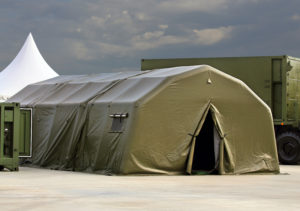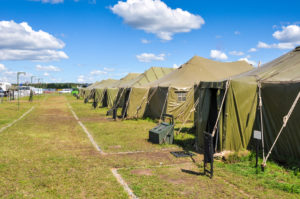Fabric structures have become an essential element in military operations around the world. These structures offer durability, flexibility, and rapid deployment capabilities, making them a valuable asset to various military branches.
Fabric structures are made with metal framing and tension fabric designed for durability and quick assembly. Due to their advantages, they contribute to the efficiency and effectiveness of military operations by providing the following uses:
- Temporary Housing And Barracks
Military forces often require temporary housing solutions during deployments, training exercises, and humanitarian missions. Fabric structures are excellent for this purpose. They’re perfect for deployable military shelter systems, as they can be easily transported, assembled, and dismantled. When utilized correctly, they can provide the necessary protection from the elements, such as rain, wind, and extreme temperatures, to ensure that troops can operate in a safe and comfortable environment. These structures can even be customized to different unit sizes and configurations, allowing for efficient organization and space utilization.

- Command And Control Centers
Aside from being temporary housing for troops, fabric structures can also act as mobile command and control centers, allowing for seamless communication between military personnel for rapid but accurate decision-making in the field. As long as you equip them with advanced communication technology, fabric structures provide a secure environment for the military leadership to plan and execute missions.
In addition to serving as command centers, fabric structures can also function as intelligence, surveillance, and reconnaissance (ISR) hubs. These facilities can house essential ISR equipment and personnel, allowing for the collection, analysis, and dissemination of vital information to support military operations.
- Training And Simulation Facilities
Military training and simulation exercises require specialized facilities that can accommodate a variety of scenarios and environments. Fabric structures offer an ideal solution for creating these facilities, providing a flexible and easily customizable space that can quickly adapt to the needs of specific training exercises. When outfitted with advanced simulation technology, fabric structures can make realistic training scenarios that enhance the preparedness of military personnel possible.
- Dining And Recreation Facilities
Maintaining morale and well-being among military personnel is essential for overall operational success. Fabric structures can provide dining and recreation facilities offering a comfortable space for troops to relax and recharge during deployments or training exercises.
The adaptability and modularity of fabric structures enable the customization of these facilities to meet the specific needs of individual units and deployments, ensuring that troops are well-cared for and supported.

- Vehicle And Equipment Storage
Proper storage of military vehicles and equipment is crucial for longevity. Fabric structures serve as an ideal storage solution, offering protection from the elements and allowing for natural ventilation. They can also be custom designed to accommodate various vehicle sizes and types, making these structures a better choice for this purpose.
In addition to providing storage, fabric structures can also act as maintenance facilities for military vehicles and equipment. With adequate lighting, power, and ventilation, these structures allow for efficient repair and maintenance operations, ensuring that military assets remain operational and combat-ready all the time.
- Fuel and Ammunition Storage
Military units need fuel for their vehicles and ammunition for their weapons, and proper storage and handling of these materials are critical for ensuring the safety and effectiveness of military operations. Fabric structures can create secure storage facilities for these vital resources, offering protection from the elements and potential security threats. When designed with specialized features such as fire suppression systems, ventilation, and reinforced walls, they can ensure the safe storage of fuel and ammunition.
- Medical Facilities And Field Hospitals
In times of conflict or disaster, rapid deployment of military medical facilities is essential for treating the injured and saving lives. Fabric structures can be quickly assembled to create field hospitals with essential medical equipment, patient beds, and sanitation facilities. And since they can withstand different weather conditions, they can provide a safe and secure environment for medical personnel to treat patients effectively.
Furthermore, fabric structures offer modularity and scalability, allowing for the expansion or contraction of medical facilities as needed. This adaptability ensures that medical resources can be optimized to meet the ever-changing demands of military medical operations.
- Decontamination And Hazmat Facilities
Like medical facilities, decontamination and hazmat facilities also play a crucial role in ensuring the safety of military personnel and civilians, especially during chemical, biological, radiological, or nuclear incidents. Fabric structures are suitable for creating temporary decontamination facilities, providing an efficient and secure environment for containing and removing hazardous materials.
Conclusion
Fabric structures have become invaluable for military operations, offering versatility, durability, and rapid deployment capabilities. These structures support various aspects of military operations, from housing and medical facilities to command centers and fuel storage. As military forces continue to evolve and adapt to new challenges, fabric structures will remain vital in ensuring their effectiveness and success.

